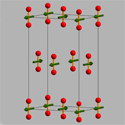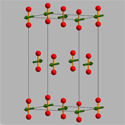Pressed to order
Of the many familiar elemental molecules—such as hydrogen, oxygen, and nitrogen—only oxygen has an electronic magnetic moment. As oxygen is cooled and solidified, it passes through several structural phases, each of which has different magnetic properties.
There are several structural phases of solid oxygen that only form under high pressure, but if—and how—the spins on the oxygen sites order is more difficult to see. Writing in Physical Review Letters, Stefan Klotz and colleagues at the Université Pierre et Marie Curie in Paris, France, and collaborators at the ETH in Switzerland and France’s Institute Laue Langevin have studied the so-called “ -phase” of solid oxygen under high pressure with neutron diffraction. At pressures of about , ( atmospheres) they have discovered that the spins on the oxygen molecules arrange into an antiferromagnet that is likely to persist up to room temperature. In addition, as they cool the solid oxygen, they identify a series of three distinct magnetic phases.
To identify these phases with neutrons, the group had to study a relatively large volume of solid oxygen—not an easy feat at high pressures. With a more complete structural and magnetic phase diagram now in hand, it will be possible to figure out what drives the multitude of phase transitions that occur in solid oxygen. – Jessica Thomas





